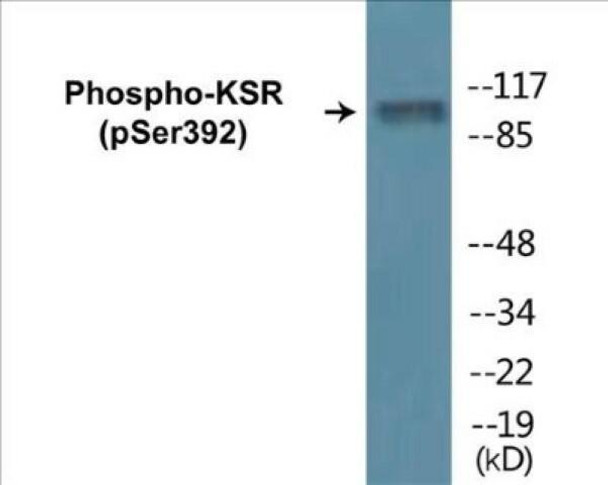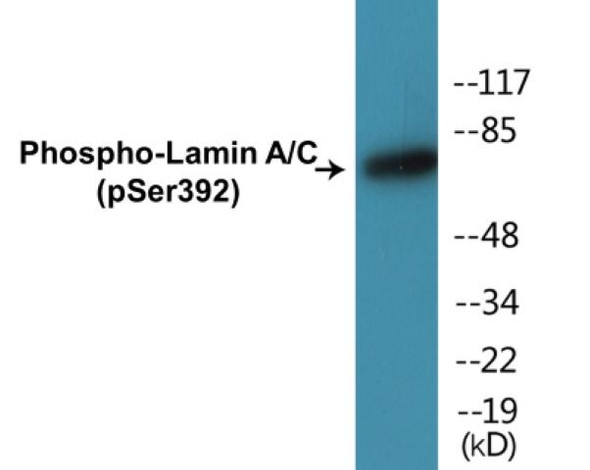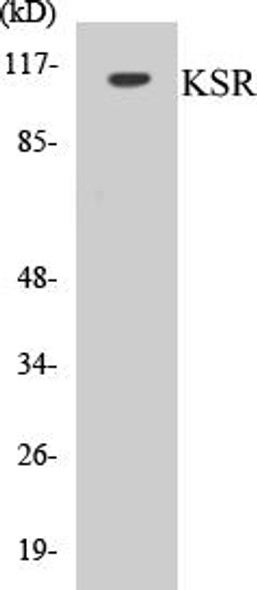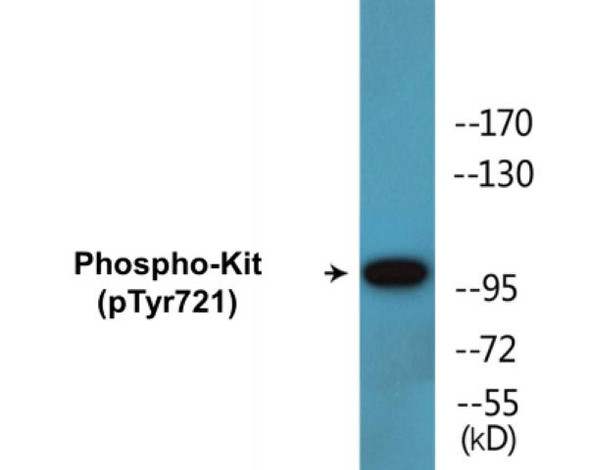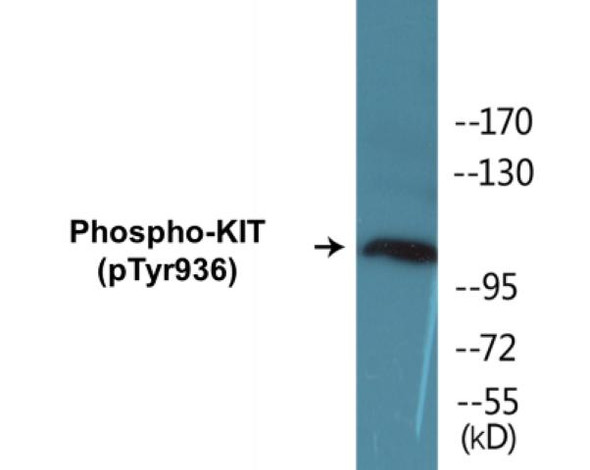Description
KSR (Phospho-Ser392)Colorimetric Cell-Based ELISA Kit
The KSR Phospho-Ser392 Colorimetric Cell-Based ELISA Kit is specifically designed for the precise detection of phosphorylated KSR (Kinase Suppressor of Ras) protein at Ser392 in cell lysates. This kit offers high sensitivity and specificity, ensuring accurate and consistent results for various research applications.Phosphorylation of KSR at Ser392 plays a crucial role in cell signaling pathways, particularly in the regulation of cell growth and proliferation. Dysregulation of KSR phosphorylation has been linked to various diseases, including cancer and inflammatory disorders, making it a valuable biomarker for studying these conditions and potential therapeutic targets.
Overall, the KSR Phospho-Ser392 Colorimetric Cell-Based ELISA Kit is a reliable tool for researchers looking to investigate the role of KSR phosphorylation in cellular processes and disease development. With its ease of use and robust performance, this kit is essential for advancing our understanding of molecular mechanisms and developing targeted therapies.
| Product Name: | KSR (Phospho-Ser392) Colorimetric Cell-Based ELISA |
| Product Code: | CBCAB01244 |
| ELISA Type: | Cell-Based |
| Target: | KSR (Phospho-Ser392) |
| Reactivity: | Human, Mouse |
| Dynamic Range: | > 5000 Cells |
| Detection Method: | Colorimetric 450 nm |
| Format: | 2 x 96-Well Microplates |
The KSR (Phospho-Ser392) Colorimetric Cell-Based ELISA Kit is a convenient, lysate-free, high throughput and sensitive assay kit that can detect KSR protein phosphorylation and expression profile in cells. The kit can be used for measuring the relative amounts of phosphorylated KSR in cultured cells as well as screening for the effects that various treatments, inhibitors (ie. siRNA or chemicals), or activators have on KSR phosphorylation.
Qualitative determination of KSR (Phospho-Ser392) concentration is achieved by an indirect ELISA format. In essence, KSR (Phospho-Ser392) is captured by KSR (Phospho-Ser392)-specific primary (1ø) antibodies while the HRP-conjugated secondary (2ø) antibodies bind the Fc region of the 1ø antibody. Through this binding, the HRP enzyme conjugated to the 2ø antibody can catalyze a colorimetric reaction upon substrate addition. Due to the qualitative nature of the Cell-Based ELISA, multiple normalization methods are needed:
| 1. | A monoclonal antibody specific for human GAPDH is included to serve as an internal positive control in normalizing the target absorbance values. |
| 2. | Following the colorimetric measurement of HRP activity via substrate addition, the Crystal Violet whole-cell staining method may be used to determine cell density. After staining, the results can be analysed by normalizing the absorbance values to cell amounts, by which the plating difference can be adjusted. |
| Database Information: | Gene ID: 8844, UniProt ID: Q8IVT5, OMIM: 601132, Unigene: Hs.133534 |
| Gene Symbol: | KSR1 |
| Sub Type: | Phospho |
| UniProt Protein Function: | KSR: a serine/threonine kinase of the Raf family with no demonstrated kinase activity. A location-regulated scaffolding protein connecting MEK to RAF. Promotes MEK and RAF phosphorylation and activity through assembly of an activated signaling complex. Interacts with RAF and MAPK/ERK, in a Ras-dependent manner. The binding of 14-3-3 proteins to phosphorylated KSR prevents the membrane localization. In unstimulated cells, the phosphorylated form is bound to a 14-3-3 protein and sequestered in the cytoplasm. Translocates from the cytoplasm to the cell periphery following TNF treatment. When Bad is available, ceramide signaling through the Ras/Raf cascade can lead to apoptosis. Three alternatively-spliced isoforms have been described. |
| UniProt Protein Details: | Protein type:Protein kinase, Ser/Thr (non-receptor); Protein kinase, TKL; Kinase, protein; TKL group; RAF family Chromosomal Location of Human Ortholog: 17q11.2 Cellular Component: cytosol; endoplasmic reticulum; endoplasmic reticulum membrane; membrane; protein complex Molecular Function:ATP binding; MAP-kinase scaffold activity; metal ion binding; mitogen-activated protein kinase kinase binding; protein binding; protein C-terminus binding; protein kinase activity Biological Process: activation of MAPKK activity; axon guidance; epidermal growth factor receptor signaling pathway; fibroblast growth factor receptor signaling pathway; innate immune response; insulin receptor signaling pathway; MAPKKK cascade; nerve growth factor receptor signaling pathway; Ras protein signal transduction; small GTPase mediated signal transduction; vascular endothelial growth factor receptor signaling pathway |
| UniProt Code: | Q8IVT5 |
| NCBI GenInfo Identifier: | 677286751 |
| NCBI Gene ID: | 8844 |
| NCBI Accession: | Q8IVT5.3 |
| UniProt Secondary Accession: | Q8IVT5,Q13476, F8WEA9, H7BYU0, |
| UniProt Related Accession: | Q8IVT5 |
| Molecular Weight: | 84,697 Da |
| NCBI Full Name: | Kinase suppressor of Ras 1 |
| NCBI Synonym Full Names: | kinase suppressor of ras 1 |
| NCBI Official Symbol: | KSR1 |
| NCBI Official Synonym Symbols: | KSR; RSU2 |
| NCBI Protein Information: | kinase suppressor of Ras 1 |
| UniProt Protein Name: | Kinase suppressor of Ras 1 |
| Protein Family: | Kinase suppressor of Ras |
| UniProt Gene Name: | KSR1 |
| UniProt Entry Name: | KSR1_HUMAN |
| Component | Quantity |
| 96-Well Cell Culture Clear-Bottom Microplate | 2 plates |
| 10X TBS | 24 mL |
| Quenching Buffer | 24 mL |
| Blocking Buffer | 50 mL |
| 15X Wash Buffer | 50 mL |
| Primary Antibody Diluent | 12 mL |
| 100x Anti-Phospho Target Antibody | 60 µL |
| 100x Anti-Target Antibody | 60 µL |
| Anti-GAPDH Antibody | 60 µL |
| HRP-Conjugated Anti-Rabbit IgG Antibody | 12 mL |
| HRP-Conjugated Anti-Mouse IgG Antibody | 12 mL |
| SDS Solution | 12 mL |
| Stop Solution | 24 mL |
| Ready-to-Use Substrate | 12 mL |
| Crystal Violet Solution | 12 mL |
| Adhesive Plate Seals | 2 seals |
The following materials and/or equipment are NOT provided in this kit but are necessary to successfully conduct the experiment:
- Microplate reader able to measure absorbance at 450 nm and/or 595 nm for Crystal Violet Cell Staining (Optional)
- Micropipettes with capability of measuring volumes ranging from 1 µL to 1 ml
- 37% formaldehyde (Sigma Cat# F-8775) or formaldehyde from other sources
- Squirt bottle, manifold dispenser, multichannel pipette reservoir or automated microplate washer
- Graph paper or computer software capable of generating or displaying logarithmic functions
- Absorbent papers or vacuum aspirator
- Test tubes or microfuge tubes capable of storing ≥1 ml
- Poly-L-Lysine (Sigma Cat# P4832 for suspension cells)
- Orbital shaker (optional)
- Deionized or sterile water
*Note: Protocols are specific to each batch/lot. For the correct instructions please follow the protocol included in your kit.
| Step | Procedure |
| 1. | Seed 200 µL of 20,000 adherent cells in culture medium in each well of a 96-well plate. The plates included in the kit are sterile and treated for cell culture. For suspension cells and loosely attached cells, coat the plates with 100 µL of 10 µg/ml Poly-L-Lysine (not included) to each well of a 96-well plate for 30 minutes at 37 °C prior to adding cells. |
| 2. | Incubate the cells for overnight at 37 °C, 5% CO2. |
| 3. | Treat the cells as desired. |
| 4. | Remove the cell culture medium and rinse with 200 µL of 1x TBS, twice. |
| 5. | Fix the cells by incubating with 100 µL of Fixing Solution for 20 minutes at room temperature. The 4% formaldehyde is used for adherent cells and 8% formaldehyde is used for suspension cells and loosely attached cells. |
| 6. | Remove the Fixing Solution and wash the plate 3 times with 200 µL 1x Wash Buffer for five minutes each time with gentle shaking on the orbital shaker. The plate can be stored at 4 °C for a week. |
| 7. | Add 100 µL of Quenching Buffer and incubate for 20 minutes at room temperature. |
| 8. | Wash the plate 3 times with 1x Wash Buffer for 5 minutes each time. |
| 9. | Add 200 µL of Blocking Buffer and incubate for 1 hour at room temperature. |
| 10. | Wash 3 times with 200 µL of 1x Wash Buffer for 5 minutes each time. |
| 11. | Add 50 µL of 1x primary antibodies Anti-KSR (Phospho-Ser392) Antibody, Anti-KSR Antibody and/or Anti-GAPDH Antibody) to the corresponding wells, cover with Parafilm and incubate for 16 hours (overnight) at 4 °C. If the target expression is known to be high, incubate for 2 hours at room temperature. |
| 12. | Wash 3 times with 200 µL of 1x Wash Buffer for 5 minutes each time. |
| 13. | Add 50 µL of 1x secondary antibodies (HRP-Conjugated AntiRabbit IgG Antibody or HRP-Conjugated Anti-Mouse IgG Antibody) to corresponding wells and incubate for 1.5 hours at room temperature. |
| 14. | Wash 3 times with 200 µL of 1x Wash Buffer for 5 minutes each time. |
| 15. | Add 50 µL of Ready-to-Use Substrate to each well and incubate for 30 minutes at room temperature in the dark. |
| 16. | Add 50 µL of Stop Solution to each well and read OD at 450 nm immediately using the microplate reader. |
(Additional Crystal Violet staining may be performed if desired – details of this may be found in the kit technical manual.)

